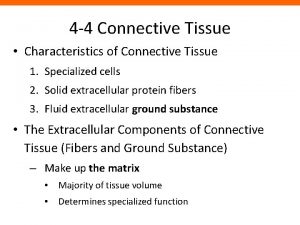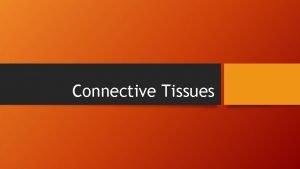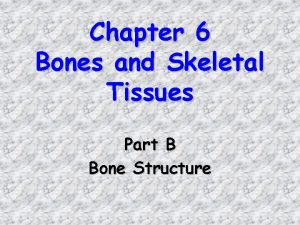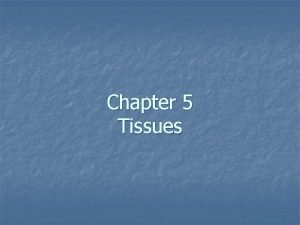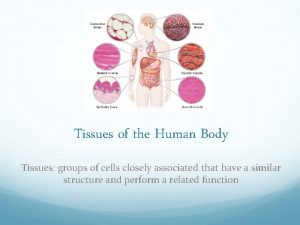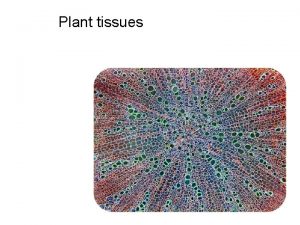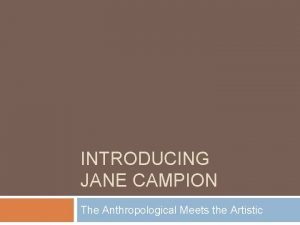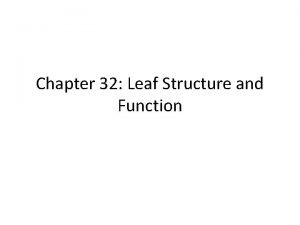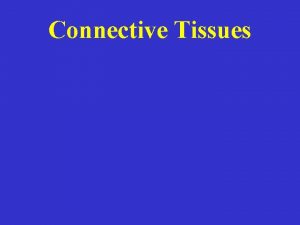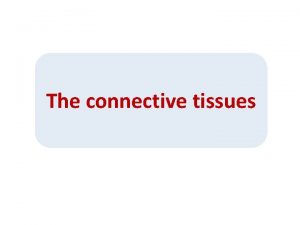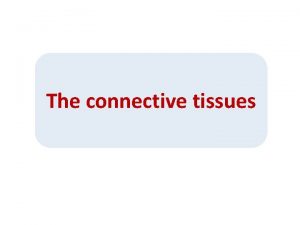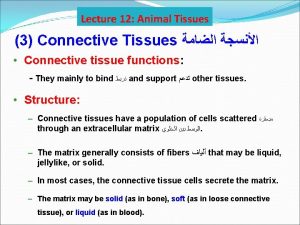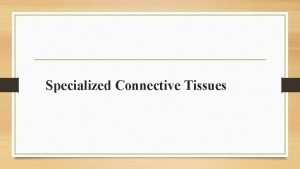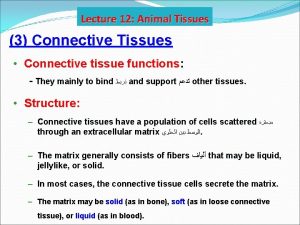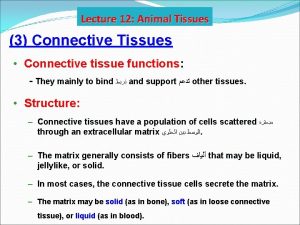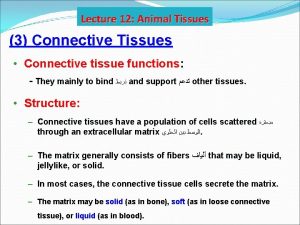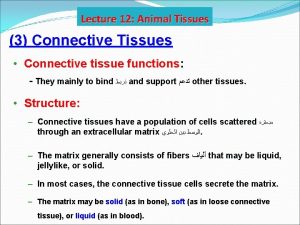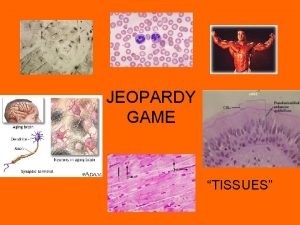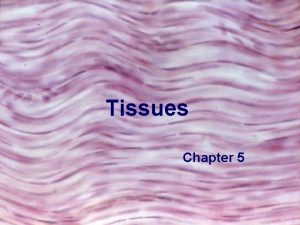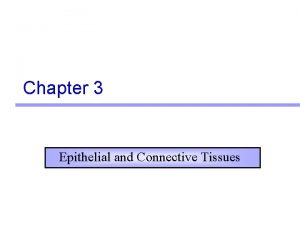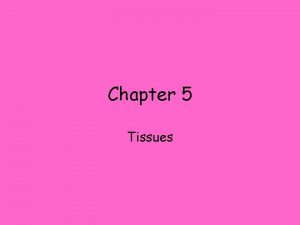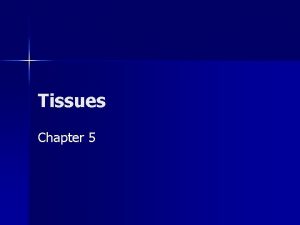Chapter 3 Connective Tissues Pages 93 97 Connective




















- Slides: 20

Chapter 3 Connective Tissues Pages 93 -97

Connective Tissue �The most abundant type of tissue! �Collagen is a major protein found in connective tissue �Also the most common protein found in the body �Functions: �Provides protection �Binds body tissues together �Supports the body © 2015 Pearson Education, Inc.

Vascularity – blood supply �Variations in blood supply �Some are well vascularized �Some have a poor blood supply or are avascular; � Examples include: tendons, ligaments � As a result, these take longer to heal © 2015 Pearson Education, Inc.

The Extracellular Matrix (ECM) �a unique and distinguishing characteristic of connective tissue �Nonliving material that surrounds living cells �Gelatinous-like material �Secreted by the connective tissue cells �Composed of two main components: �Ground Substance �Fibers © 2015 Pearson Education, Inc.

Ground Substance � Secreted by connective tissue cells � Similar to cytosol in composition and function � Composed of: � mostly water � adhesion proteins � polysaccharides

Fibers �Secreted by connective tissue cells �Three types: 1. Collagen (white) fibers � Allow CT to withstand pulling/tension 2. Elastic (yellow) fibers � Contain elastin- allows stretching 3. Reticular fibers (a type of collagen) � Short fibers that create a mesh-like network

Connective Tissue Types �From most rigid to softest, (or most fluid): �Bone �Cartilage �Dense connective tissue �Loose connective tissue �Blood © 2015 Pearson Education, Inc.

BONE �Known as osseous tissue �Produced by Osteocytes (bone cells) �A Hard matrix of calcium salts �Functions to protect and support the body © 2015 Pearson Education, Inc.

Figure 3. 19 a Connective tissues and their common body locations. BONE Bone cells in lacunae Central canal Lacunae Lamella (a) Diagram: Bone Photomicrograph: Cross-sectional view of ground bone (165×)

CARTILAGE �more flexible than bone �Found in only a few places in the body �Produced by Chondrocytes (cartilage cell) �Three types of cartilage: �Hyaline (most abundant; larynx, intercostal, bone ends) �Elastic (external ear and epiglottis) �Fibrocartilage (intervertebral discs; pubic symphysis) © 2015 Pearson Education, Inc.

Figure 3. 19 b Connective tissues and their common body locations. HYALINE CARTILAGE Chondrocyte (cartilage cell) Chondrocyte in lacuna Lacunae Matrix (b) Diagram: Hyaline cartilage Photomicrograph: Hyaline cartilage from the trachea (400×)

Figure 3. 19 c Connective tissues and their common body locations. FIBROCARTILAGE Chondrocytes in lacunae Collagen fibers Collagen fiber (c) Diagram: Fibrocartilage Photomicrograph: Fibrocartilage of an intervertebral disc (150×)

DENSE CONNECTIVE TISSUE �Strong, ropelike structures �Main matrix element is collagen fiber made by fibroblasts �Locations: � Tendons—attach skeletal muscle to bone � Ligaments—attach bone to bone at � Dermis—lower layer of the skin �Found where strength of interconnection is required © 2015 Pearson Education, Inc.

Figure 3. 19 d Connective tissues and their common body locations. DENSE CONNECTIVE TISSUE: Ligament And Tendon Ligament Tendon Collagen fibers Nuclei of fibroblasts (d) Diagram: Dense fibrous Photomicrograph: Dense fibrous connective tissue from a tendon (475×)

LOOSE CONNECTIVE TISSUE �softer tissues; less fibrous �provide cushioning, reduce friction, allow stretching �Three types: �Areolar: wraps and secures organs � Lamina propria: areolar layer that underlies all mucous membranes �Adipose: fat cells; energy storage; insulation �Reticular: provides structural framework for organs/glands © 2015 Pearson Education, Inc.

Figure 3. 19 e Connective tissues and their common body locations. AREOLAR CONNECTIVE TISSUE Mucosa epithelium Lamina propria Elastic fibers Collagen fibers Fibroblast nuclei Fibers of matrix Nuclei of fibroblasts (e) Diagram: Areolar Photomicrograph: Areolar connective tissue, a soft packaging tissue of the body (270×)

Figure 3. 19 f Connective tissues and their common body locations. ADIPOSE TISSUE Nuclei of fat cells Vacuole containing fat droplet (f) Diagram: Adipose Photomicrograph: Adipose tissue from the subcutaneous layer beneath the skin (570×)

Figure 3. 19 g Connective tissues and their common body locations. RETICULAR CONNECTIVE TISSUE Spleen White blood cell (lymphocyte) Reticular cell Blood cell Reticular fibers (g) Diagram: Reticular Photomicrograph: Dark-staining network of reticular connective tissue (400×)

BLOOD �Blood cells = red and white �surrounded by fluid matrix known as blood plasma �Soluble fibers are visible only during clotting �Function: transport vehicle for the CV system; delivers: � Nutrients � Wastes � Respiratory gases (oxygen and carbon dioxide) © 2015 Pearson Education, Inc.

Figure 3. 19 h Connective tissues and their common body locations. BLOOD Blood cells in capillary Neutrophil (white blood cell) Red blood cells White blood cell Red blood cells (h) Diagram: Blood Monocyte (white blood cell) Photomicrograph: Smear of human blood (1290×)
 Body tissue
Body tissue The four major categories of tissues are
The four major categories of tissues are Body tissues chapter 3 cells and tissues
Body tissues chapter 3 cells and tissues Chapter 3 cells and tissues
Chapter 3 cells and tissues Eisonophil
Eisonophil Printed pages vs web pages
Printed pages vs web pages Connective tissue
Connective tissue Connective tissues characteristics
Connective tissues characteristics Elastic tissue function and location
Elastic tissue function and location What do all connective tissues have in common
What do all connective tissues have in common Chapter 6 bones and skeletal tissues
Chapter 6 bones and skeletal tissues Chapter 3 cells and tissues
Chapter 3 cells and tissues Chapter 3 cells and tissues figure 3-1
Chapter 3 cells and tissues figure 3-1 Chapter 5 tissues
Chapter 5 tissues Smooth endoplasmic
Smooth endoplasmic Body tissue
Body tissue Procambium
Procambium 3 tissues of a plant
3 tissues of a plant 3 tissues of a plant
3 tissues of a plant Jane campion tissues
Jane campion tissues Upper epidermis function in photosynthesis
Upper epidermis function in photosynthesis







